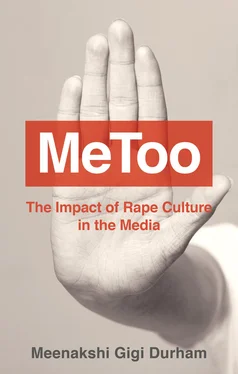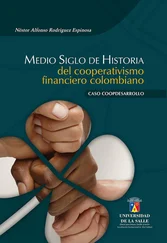From these online engagements it has become clear that the media are not only the physical sites of rape culture in the workplace, they are also an active discursive site of interrogation about rape and the cultures that produce it, sustain it, and conceal it. Like Tarana Burke’s “me too™” movement, #MeToo served in the first place to create a space for survivors to voice the experience of sexual violence, as it was impelled by a keen recognition that accounts of sexual abuse and assault are routinely stifled by dominant institutions and their powers of insidious sexual censorship. I use the term “censorship” to claim, not that survivors’ stories are explicitly excised from any public record, but rather that sexual violence survivors face powerful cultural silencing mechanisms that often prevent them from disclosing their victimization: they are disbelieved, blamed for the assault, accused of wanting and even enjoying it, retraumatized through enforced retellings of the incident and brutal interrogations about it, persuaded to take hush money and sign nondisclosure agreements, shunned by families and communities as a consequence of their injury, stigmatized, and even persecuted or prosecuted. Hence #MeToo served a “silence-breaking” purpose, providing an outlet for speaking the realities of sexual violence in which survivors could find a community of support. Such movements had been emerging in many spaces and places around the globe; #MeToo, for a variety of reasons, including its genesis in the United States and its connections to powerful white celebrity women, both accelerated these movements and eclipsed them.
Survivors’ ability to speak is inflected by race, class, gender, and other intersecting sociocultural factors. The legal scholar Angela Onwuachi-Willig has pointed out that “[t]he recent resurgence of the #MeToo movement reflects the longstanding marginalization and exclusion that women of color experience within the larger feminist movement in US society,” 5despite the fact that women of color have been in the vanguard of legal action and community organizing against sexual violence, and despite their greater vulnerability to both sexual harassment and silencing.
In all these ways, the so-called MeToo moment, itself a media invention, highlights the implications of rape culture for our media organizations, representations, and discourses. That, as I just argued, the media themselves serve as a conduit for rape culture is not a new idea: even as rape culture emerged as a powerful concept in second-wave feminism, its relationship to media culture was clear. 6The very term “rape culture” was coined during that period, in the 1970s, and gained traction as feminist activists and thinkers started to recognize sexual violence as an outcome of patriarchal power, “a systemic problem that is institutionalized throughout the society.” 7This perspective radically revised traditional perceptions of instances of rape as isolated phenomena caused by deviant individuals enticed by blamable victims.
The reframing of rape as a systemic or structural problem was, even at the time, complicated by issues of race and class that were raised in the writings and speeches of women of color. The legal scholar Kimberlé Crenshaw crystallized these themes in a landmark essay, in which she pointed out that “the violence that many women experience is often shaped by other dimensions of their identities such as race and class;” 8women of color experience sexual assault in ways that differ from how white women experience it. The neglect of racial and other factors, she argued, was another way of silencing survivors, as it “relegated the identity of women of color to a location that resists telling.” 9Thanks to these theorizations, the intersectionality of race, class, gender, and other identity markers is now an essential component of feminist approaches to rape culture, as well as to all aspects of culture and society.
The feminist scholar Ann Russo reminds us that race, class, sexual orientation, and other identity categories afford “differential access to a claim of innocence” in sexual assaults. 10Her insight underscores how sexual assault survivors, unlike victims of other crimes, are automatically suspected of lying about their assaults. Skepticism about survivors’ “innocence” also implies that they were somehow “guilty” or complicit in their own victimization. The idea that sexual violence survivors fabricate the stories of their assault is one among the many “rape myths” that form the building blocks of rape culture.
Feminist contemplation and theorization of sexual violence has identified a series of prevalent “rape myths,” which are deeply embedded in many contemporary cultures and serve to undermine the credibility and capability of survivors. 11As a consequence of these myths, rape is allowed to flourish as a social norm. A substantial body of feminist scholarship 12has identified the following prevailing rape myths:
Only “bad girls” get raped (which implies that survivors’ behavior, clothing, sexual history, and attitude invite rape).
Women enjoy rape (although this myth is largely gendered and not projected onto all survivors, it is nonetheless used in many contexts to rationalize rape).
Survivors lie about being raped, especially if they have a grudge against the perpetrator.
Survivors confuse “bad sex” with rape.
If the survivor was drunk or used other judgment-impairing substances, the act was not rape.
There is only one definition of rape: it is heterosexual, it involves penile–vaginal penetration, it is perpetrated by a male stranger on an unsuspecting woman, it involves the use of a weapon or considerable force, and it must be corroborated by evidence of resistance on the part of the female victim. This myth places responsibility for rape on the victim and eliminates the possibility of marital rape, rape by an acquaintance, same-sex rape, male rape, or rape of trans people; it also misses sexual violence that does not involve heterosexual intercourse. Although the US Department of Justice currently has a much more expansive and reasonable legal definition of rape,13 this myth is still culturally prevalent in the United States and in many other societies.
Other rape myths refer specifically to racial and class stereotypes: “the placid Indian ‘squaw’ who readily gives her sexual favors, the passionate Black or mulatto woman who is always ready and sexually insatiable, the volatile Mexican woman who is fiery eyed and hot blooded, and the languid, opium-drowsed Asian woman whose only occupation is sex.” 14Racialized rape myths also specify what counts as a “credible” survivor and as a “credible” account of rape. In recent research, factors such as the race, class, gender, and sexual orientation of victims and perpetrators are found to play a significant role in the treatment of victims by the police, as well as in prosecutors’ decisions as to whether to accept a case. 15The ways in which race, class, sexual orientation, gender identity, and disability are used to discredit and trivialize sexual violence survivors leaves some of them with fewer legal protections than others and inhibits the reporting of sexual violence.
The silencing of sexual violence survivors as a result of the influence of rape myths is one of the most serious consequences of rape culture. Sexual assault survivors are reluctant to report for a range of reasons, many of which are related to fears created by rape myths. It is telling that such fears are reflected in studies across a wide range of countries and cultures, races and identities. Worldwide, a pitifully small percentage of sexual assaults are reported to the police or other authorities: the estimates of reported cases of sexual violence range from 5 to 25 percent of the number of actual cases. 16Even for rich and famous white women in the global North, a culture of silence allowed multiple incidents of sexual assault, abuse, and harassment to continue unchecked for decades in some of the world’s wealthiest corporations.
Читать дальше












